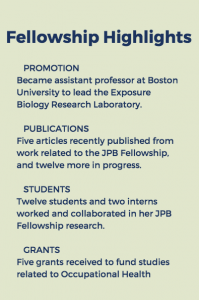Diana Ceballos, Assistant Professor of Environmental Health at Boston University (Senior Fellow 2014-2017) shares how the JPB EH Fellowship opened horizons to a more in depth understanding of the social factors related to vulnerable populations.

The JPB EH Fellowship opened my horizons to a more in depth understanding of the social factors related to vulnerable populations. It helped me understand better academic life, increase my network, create friends with a similar vision and goals in life which are very important to persevere in your career. Ultimately, this fellowship gave me the funds to do a project I had dreamed of doing for a while and has helped me apply for grants in agencies where I never thought I would be able to apply to before.
“The fellowship was a life changing, life transforming, and unforgettable experience. I always looked forward to the workshops and every time I came back renewed and feeling I could really change the world”.
The Support of Directors was Essential
Without the directors supporting us, this fellowship would not have been what it was. Their full whole hearted dedication, vision, passion, and intention made this undoubtedly what it was. The fellowship created a safe space to dream about projects that we may have perhaps not gotten the guts to go forward with or think they were possible and got constructive feedback and encouragement to pursue them.
 Fellowship Project: Assessing the Role of Occupation on Home Exposures in a Disadvantaged Community
Fellowship Project: Assessing the Role of Occupation on Home Exposures in a Disadvantaged Community
Being an immigrant, low English proficiency, and low levels of education have been associated with higher rates of injuries among minorities. Minority workers may also have a higher likelihood to hold the so-called “dirty jobs,” being exposed to chemicals at work, and transporting chemicals home from work, known as “take home.” Further, health disparities could exacerbate how work interplays with exposures at home and how it ultimately affects health. This study aims to better understand the connection between home and work-related exposures in a high-risk community by identifying occupation-specific sources of home exposure. We will assess the relationship between home and potential for take home with a survey and environmental sampling for metals and semi volatile compounds (SVOCs) including polychlorinated biphenyls (PCBs). Participants and household members will be referred to the Massachusetts Department of Public Health (MDPH) Biomonitoring Massachusetts Study for biomonitoring of metals and PCBs to verify take home. We will work with the Massachusetts Coalition for Occupational Safety & Health (MassCOSH) to train participants on ways to mitigate these exposures. This project is also funded by CRESSH
Recent Publications
Bakhiyi B, Labrèche F, Gravel S, Ceballos D, Flynn M, Zayed J. Has the question of e-waste opened a Pandora’s Box? An overview of unpredictable issues and challenges of recycling. Environmental International, Vol 10, Pages 173–192, 2018.
Beaucham C, Ceballos D, Mueller C, Page E, La Guardia M. Field evaluation of sequential hand wipes for flame retardant exposure in an electronics recycling facility. Chemosphere 10.1016/j.chemosphere.2018.12.027
Ceballos D, Broadwater K, Page E, Croteau G, La Guardia MJ. Occupational Exposure to Polybrominated Diphenyl Ethers (PBDEs) and Other Flame Retardant Foam Additives at Gymnastics Studios: Before, During and After the Replacement of Pit Foam with PBDE-Free Foams. Environmental International, 116:1-9, 2018.
Ceballos, Diana & West, Christine & Methner, Mark & Gong, Wei. (2018). Hexavalent Chromium Exposure and Nasal Tissue Effects at a Commercial Aircraft Refinishing Facility. Journal of Occupational and Environmental Medicine. 1. 10.1097/JOM.0000000000001510.
Young AS, Allen JG, Kim UJ, Seller S, Webster TF, Kannan K, Ceballos DM. Environ Sci Technol. 2018. doi:10.1021/acs.est.8b04495 [Epub ahead of print].